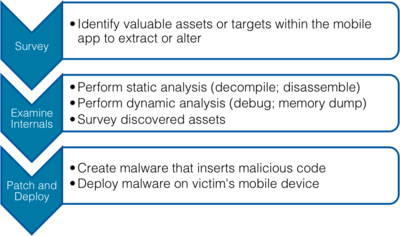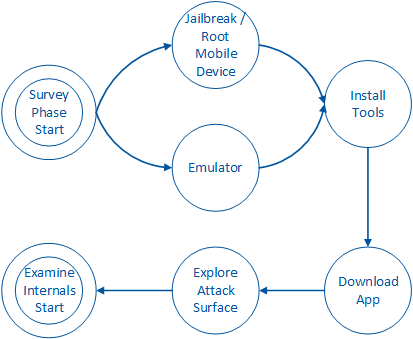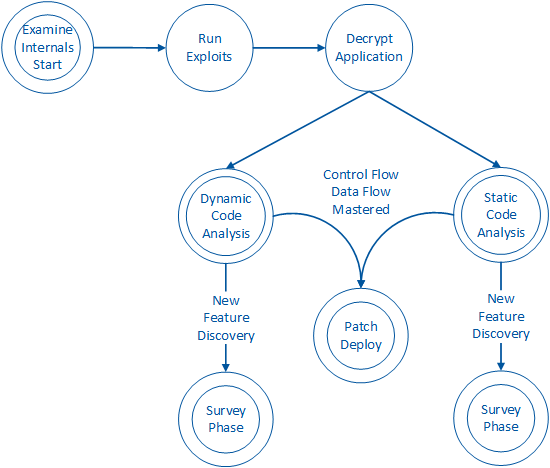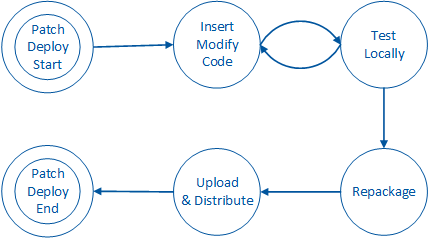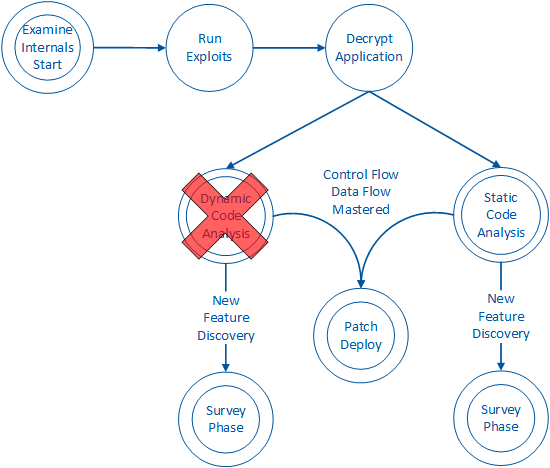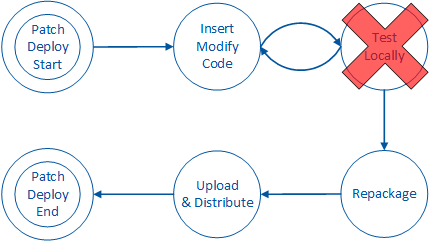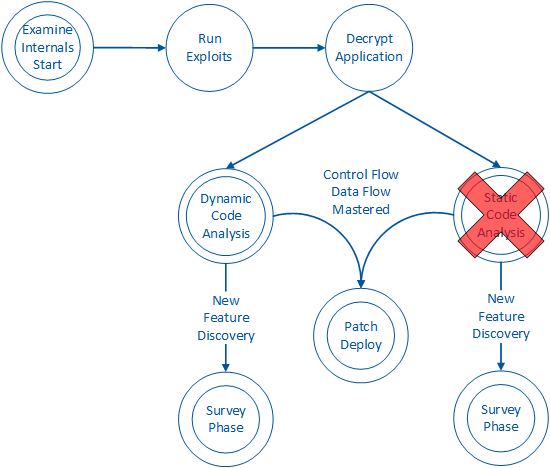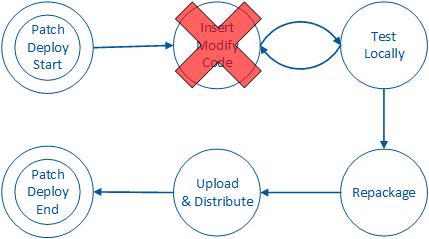This site is the archived OWASP Foundation Wiki and is no longer accepting Account Requests.
To view the new OWASP Foundation website, please visit https://owasp.org
Architectural Principles That Prevent Code Modification or Reverse Engineering
![]() This content is part of a much bigger project. To return to the main umbrella project, visit the Reverse Engineering and Code Modification Prevention Project.
This content is part of a much bigger project. To return to the main umbrella project, visit the Reverse Engineering and Code Modification Prevention Project.
Introduction
Relevant Audiences
This guide is relevant to technical audiences that are responsible for designing or proposing the technical architecture behind software that is hosted in an untrustworthy environment. Untrustworthy environments are those not under a developer’s control. Although this guide identifies risks that apply to all untrustworthy environments (e.g., firmware, thick-clients, cloud), specific examples and attacks are provided using mobile devices.
Often, relevant technical audiences have the following role titles:
- * Enterprise Architect;
- * Solution Architect;
- * Security Architect;
- * Software Architect;
- * Infrastructure Security Specialist Architect;
- * Web Application Security Architect; or
- * Lead Software Engineer
The relevant audience is interested in exploring architectural features of software that should be included to mitigate mobile application operational risks related to application integrity violation.
Goals of this Guide
This guide helps Architects formulate appropriate application solutions that mitigate operational risks specific to mobile device applications. These risks are outlined in a related OWASP project titled, "Technical Risks of Reverse Engineering and Unauthorized Code Modification".
This project has several different goals that are outlined below:
Integrity Risk Education
Software Architects must take into account many different competing design factors when proposing a technical architecture for a mobile device application. When considering the security of the application’s solution, architects must propose various controls that will mitigate several different types of operational risk. Relevant technical risks that stem from mobile device applications include: hardware infrastructure, code, and application integrity. This section of the guide highlights application integrity risks that an architect should be aware of when designing mobile device application solutions.
Architectural Solution Components
To reduce application integrity risks to an acceptable level, an architect must integrate particular security controls at the right locations within the mobile device application. This section of the document highlights a catalog of potential architectural controls that are relevant to mitigating application integrity violation risks. As part of the architectural formulation process, the architect must choose particular technologies to leverage in the final solution. These choices can have varying impacts on the following aspects of the mobile device application: performance; scalability; and maintenance. This section of the guide highlights the potential impacts of integrity security controls on the final solution.
Integrity Risk Education
Evolution of Application Security Threat Landscape
Historically, organizations offered their customers web applications that exposed an interface to some necessary business services. The services expose high-value functionality that allows an organization to deliver value to its clients. Attackers had a specific set of threats or goals that they realized by exploiting vulnerabilities that the organization exposed through the application’s presentation layer. Security practitioners address these specific sets of vulnerabilities through the web application or the associated infrastructure security disciplines.
Often, attackers launch successful attacks by providing malicious input that they fed into the web application’s presentation layer. Classic attack vectors used by attackers that use this technique include: SQL Injection, Cross-Site (XSS) Scripting, and URL parameter tampering vulnerabilities. Often, security professionals detect the presence of these vulnerabilities through source code analysis or penetration testing. In response to the detection, security professionals recommend to the organization that its Software Engineers should mitigate these vulnerabilities by applying secure coding techniques and adding appropriate data validation security controls to the affected application. Generally, this is sage advice and it works well for traditional web-based applications. In this common scenario, this advice is enforceable because the organization is hosting the web application in a highly controlled (more trustworthy) environment where only the organization’s Software Engineers can modify the application’s underlying code.
In present day, consumers have demanded much more convenient access to functionality than what organizations could traditionally offer through web applications accessible via desktop browsers. In response to these demands, organizations began augmenting the user experience with mobile applications.
In making the switch to mobile applications, organizations are now deploying more of the presentation layer and business layer of the application on a mobile device instead of on their own servers. As a result, they lose a lot more control over who gets to see or modify their application’s code. Before the switch, most of the application’s presentation and business layer functionality was hidden within the organization’s trusted server environments. Outside users or attackers did not get much of an opportunity to see executing code in action. With the recent move towards mobile applications, an attacker can now see, touch, and directly modify the application’s presentation and business layer code within the attacker’s mobile computing environment. This capability allows the attacker to realize the same traditional business threats as before (with web applications) but in genuinely new and unconventional ways.
In general, attackers have far more security expertise than the computing industry and are quite successful in exploiting mobile application integrity risks. Most mobile application Software Engineers are not producing mobile applications that will defend themselves against reverse engineering by the attacker.
Application Integrity Threats
Attackers can now leverage reverse-engineering / code modification attack techniques inside mobile device applications to realize the following threats:
- Spoofing Identity
- Attackers may attempt to modify the mobile application code on a victim’s device to force the application to transmit a user’s authentication credentials (username and password) to a third party malicious site. Hence, the attacker can masquerade as the user in future transactions;
- Tampering
- Attackers may wish to alter higher-level business logic embedded within the application to gain some additional value for free. For instance, an attacker may alter digital rights management code embedded in a mobile application to attain digital assets like music for free;
- Repudiation
- Attackers may disable logging or auditing controls embedded within the mobile application to prevent an organization from verifying that the user performed particular transactions;
- Information Disclosure
- Attackers may modify a mobile application to disclose highly sensitive assets contained within the mobile application. Assets of interest include: digital keys, certificates, credentials, metadata, and proprietary algorithms;
- Denial of Service
- Attackers may alter a mobile device application and force it to periodically crash or permanently disable itself to prevent the user from accessing online services through their device; and
- Elevation of Privilege
- Attackers may modify a mobile application and redistribute it in a repackaged form to perform actions that are outside of the scope of what the user should be able to do with the app.
Steps to Conduct an Attack
|
Unprotected mobile apps can easily be cracked open, analyzed, modified, and exploited by hackers. In addition to exploiting flaws, attackers can directly access the binary and compromise its integrity with various tools and techniques:
Safe coding alone cannot prevent these attacks as code written with secure coding techniques can be reverse-engineered and modified. To realize mobile app integrity threats, the attacker will execute the steps highlighted in the graph to the left in order to conduct a reverse engineering attack against the mobile device app. |
Attacks using this technique are now fairly common and achievable. Studies show that today's mobile banking apps were largely not protected against reverse-engineering or tampering attacks. These apps revealed highly sensitive information that should not be disclosed, and their operations and data were exposed in the clear, wide open to examination and manipulation.
Survey Phase
Figure 1 illustrates the general steps that an attacker must successfully execute in order to gather intelligence about the app they wish to integrity-attack:
For an iOS mobile app, the attacker will need to compromise their own iOS device and trick it into downloading and executing malicious tools that allow the attacker to inspect other apps on the iOS device. This occurs during the ‘Exploit Phone’ and ‘Install Inspection Tools’ phases depicted by Figure 1. After the attacker has successfully compromised their own iOS device and installed the necessary exploit tools, the attacker proceeds to download the legitimate app. Figure 1 depicts this act in the ‘Download App to Phone’ state. For an Android app, the attacker does not necessarily need to compromise their device. Instead, the attacker can try running the inspection tools directly within an Android emulator and explore the attack surface of the app from within it. If this does not work, the attacker can then compromise their device and inspect using the same tools.
After the attacker has downloaded the app, the attacker will explore the exposed functionality of the app. Often, the attacker will pay attention to sensitive data that is processed by the app. Once the attacker has examined any exposed functionality or data provided by the user of the mobile device app, the attacker will need to understand how these assets are processed by the underlying code. Figure 1 depicts this in ‘Examine Internals’ phase.
Often, the attacker will go back and forth between discovering new features of the app and exploring its underlying design at the same time:
Examine Internals Phase
Once the attacker has established a threat and a goal in mind, the attacker will need to understand how the app works in order to compromise these assets. Figure 3 depicts this phase of the mobile device compromise:
On some platforms (Android), an app can simply be opened directly for further inspection. On other platforms (iOS), an attacker will use one of many automated and fairly inexpensive tools to decrypt and then open the app. Figure 3 depicts this within the ‘Run Exploits’ and ‘Decrypt Application’ processes.
After obtaining the original binary, the attacker can choose to perform static analysis. Figure 3 depicts this within the ‘Static Code Analysis’ process. Furthermore, the attacker may also engage in dynamic analysis to observe the runtime behavior of the app. This is depicted as the ‘Dynamic Code Analysis’ process in Figure 3. In both states, the attacker needs to acquire particular intelligence about the app in order to violate its integrity. Desirable intelligence includes how data flows through the app. As well, an attacker will want to know more about how the app’s code changes control flow paths along various points of interaction with the end user. In acquiring this intelligence, the attacker can learn how to alter the flow of sensitive data, bypass important functionality and modify the behavior of the app.
Upon detailed analysis, the attacker may discover new product features or abilities that were not exposed through the user interface. For example, an attacker may discover and enable diagnostic features that disclose sensitive information about how the app works. Figure 3 depicts this as a return to the ‘Survey Phase’ states.
Often, the attacker will spend a lot of time going back and forth between formulating a payload and examining the internals of the app. Figure 4 depicts this back-and-forth relationship between these two phases of the operation:
Patch / Deploy Phase
An attacker may decide that this phase is unnecessary in order for them to achieve their goals. For example, an attacker may choose to lift algorithms, extract keys, or gain other sensitive information through the previous phase using static analysis or dynamic analysis tools.
If the attacker intends on altering the behavior of the app, the attacker must formulate a malicious payload that will alter the app’s control or dataflow. The attacker then inserts the payload into the binary and may execute it only on their mobile device, or they may choose to distribute the modified binary to a wider audience.
These steps are depicted in the following figure:
During this phase, the attacker spends a lot of time experimenting with code modifications or additions and observing how the app responds. Once the attacker is satisfied that the modified code behaves accordingly, the attacker has many different distribution options.
Conventionally, the attacker inserts malicious code into the legitimate app and redistributes it within a third-party store for distribution. The victim downloads the modified app through the third-party app store and executes it locally on their mobile device. At this point, the attacker has successfully conducted an integrity attack and some sort of fraud against the user of the app.
Alternatively, the attacker may wish to conduct fraud against the organization that owns the app rather than the users of the app. In this scenario, the attacker modifies the app on their device with the goal of exploiting a server-side vulnerability. The attacker does not have to distribute any code to a third-party site in order to conduct fraud against the organization.
App Modification Threat Examples
It is very common for an attacker to disable security controls and policies or modify critical functionality. According to Forrester Research, “Tampering and logic fraud rates are seen increasingly within mobile environments.”
Common attack targets include:
- Security controls and policies;
- Credentials;
- Cryptography keys;
- Communication interception; and
- Modification of business logic and restricted functionality.
According to a 2012 study conducted by North Carolina State University, app-repackaging attacks were the most common form of attack executed by a hacker. Through repackaging, the attacker installs a malicious payload through disassembly, payload insertion, and re-assembly. This malware may infect other apps on the same device without the owner’s knowledge.
The NC study concludes that common malicious payloads include:
- Remote control through command-and-control botnets - 93%;
- Information stealing (user accounts; sensitive date) – 51%;
- Financial charging – 45%; and
- Privilege escalation – 37%.
Architectural Solution Components
Mobile app threats are similar to threats seen within traditional web applications. To mitigate such threats within traditional web applications, the organization should include appropriate web application security controls that are built using secure coding techniques. Mobile device apps are similar enough to traditional web applications that the organization should apply the same secure coding techniques for mobile device apps. However, mobile device apps are hosted within an untrustworthy environment. As such, they require additional security controls to mitigate the added risks associated with integrity violation.
The primary goal of including integrity controls is to disrupt or prevent the steps necessary to conduct a successful integrity attack against a mobile app. Each subsection below outlines the relevant controls that must be put in place to prevent such an attack. Impacts on the confidentiality, integrity, and availability of the solution are also considered below.
Controls
This section of the guide outlines the specific integrity controls that an architect should consider when choosing to protect the integrity of a mobile app.
AntiDebug Controls
Within the ‘Examine Internals’ phase of an attack (outlined in “Steps to Conduct an Attack” section of this document), the attacker may choose to examine the app while it is executing to gain a better understanding of the app’s code structure and control flow. The attacker may choose to do so by inserting a debugger into the app’s process. This control prevents the attacker from injecting a debugger into the process and conducting dynamic code analysis:
In order to prevent modification of code or data at runtime, other controls are necessary to detect and react to such violations. These controls are explored below.
Checksum Control
During the ‘Patch and Deploy’ phase of an attack, the attacker will need to inject malicious code and test that the app behaves “correctly”. The checksum integrity control compares a selected region of code at runtime to what it knows at build time. If the two are not equal, the integrity control has successfully identified an unexpected code change. It is then up to the app to decide how to react to such an unexpected change:
Static Damage Control
Within the ‘Examine Internals’ phase of an attack (outlined in “Steps to Conduct an Attack” section of this document), an attacker may wish to gain further intelligence about the app’s control flow via static analysis tools like IDA Pro or Hopper. At build time, a Static Damage control “damages” a region of code and stores it in some other location in the binary. When an attacker attempts to perform static analysis against the code region they will be misled by the protected region. The organization can choose to replace the protected region with encrypted code or unencrypted but unrelated (and misleading) code. At runtime, the organization must then leverage Dynamic Repair controls to replace the protected code with a known good copy prior to execution. This control prevents static analysis of sensitive code:
During the ‘Patch and Deploy’ phase of an attack, the attacker will need to inject malicious code and test that the application behaves correctly. The Dynamic Repair control prevents the attacker from applying and executing malicious code at runtime. This control is typically used in unison with a Static Damage control. The Static Damage control is responsible for preventing static analysis. At runtime, the “damaged” code must be repaired in order to execute the correct code. The Dynamic Repair control replaces the “damaged” code in memory with the known good copy of the code just before execution. This good copy prevents the execution of any modified code inserted by the attacker. After the code executes, it is important to “re-damage” code in memory using a Dynamic Damage Control.
The Dynamic Repair control prevents an attacker from inserting modified code into protected code regions:
Dynamic Damage Control
During runtime, an attacker may wish to attach a debugger to a process to see what unencrypted code looks like in memory. For example, ClutchMod is a particularly useful tool to examine unencrypted code in the memory of iOS devices. Dynamic Damage controls will replace protected code in memory with other code segments in a way similar to the way Static Damage controls work on disk. After a Dynamic Repair control repairs code to a known good state and the code executes, a Dynamic Damage control is responsible for replacing the good code with another copy of the “damaged” or misleading code stored in the binary.
Dynamic Damage controls prevent an attacker from inspecting code or data within the app’s memory at runtime:
Obfuscation Control
Within the ‘Examine Internals’ phase of an attack (outlined in “Steps to Conduct an Attack” section of this document), an attacker may wish to gain further intelligence about the application’s code by looking at the code while it is not executing. To do so, the attacker may choose to engage in static code analysis. The obfuscation control is responsible making code difficult to understand during static code analysis. Code can be made harder to understand through a number of different techniques. These techniques include: polymorphic obfuscation, method-inlining, insertion of opaque predicates, instruction substitution, and instruction block chopping.
Effective obfuscation forces the attacker to perform dynamic analysis instead:
Renaming Control
Within the ‘Examine Internals’ phase of an attack (outlined in “Steps to Conduct an Attack” section of this document), an attacker may wish to gain further intelligence about the application by looking at the application’s user-specified symbols while the application is not executing. To do so, the attacker may choose to engage in static code analysis. The renaming control is responsible for making user-specified symbols (code or data) difficult to understand through static code analysis. It is different from an Obfuscation control in that its scope is severely reduced to just user-supplied class fields and methods directly exposed through the binary. This has the advantage of reduced impact on size and performance in comparison to applying traditional obfuscation techniques. However, it has the disadvantage of shallow obfuscation.
This control strives to prevent static analysis:
String Damage Control
Within the ‘Examine Internals’ phase of an attack (outlined in “Steps to Conduct an Attack” section of this document), an attacker may wish to gain further intelligence about the application’s internal data by looking at the application’s string table. To do so, the attacker may choose to engage in static code analysis. The String Damage control is a form of obfuscation that is severely reduced in scope to that of the string table. It is similar to a Static Damage control in that it encrypts static data. However, it focuses exclusively on the string table and prevents an attacker from inspecting the string contents at runtime. At runtime, it must also use a corresponding Dynamic Repair Guard to replace “damaged” strings with known good strings just before consumption.
A String Damage control is responsible for making an app’s internal data difficult to understand and associate with sensitive methods during static code analysis:
Jailbreak / Root Detection Controls
During the ‘Patch and Deploy’ phase of an attack, the attacker may need to inject malicious code and test that the app behaves as the attacker intends. The attacker may need to do this on a mobile device that the attacker has compromised. For iOS devices, the Jailbreak control will prevent the attacker from injecting and executing malicious code within the mobile app:
The victim may run the legitimate version of the app on a Jailbroken device. In such a scenario, the device’s overall security has been compromised. It may be possible to compromise the legitimate app due to its dependencies for security features contained within its environment. The Jailbreak control prevents the app from running at all within the untrustworthy environment.
Technical Impacts of Controls
Each section below outlines the impacts on a solution that may result from the inclusion of integrity security controls in the final solution.
Performance
When an integrity control is inserted into a mobile application, the mobile application will have additional overhead in performing its functionality. When an integrity control is invoked by the application, the application must execute the code associated with that instance of the integrity control. The amount of resource consumption is dependent upon a number of different factors: the algorithm behind the control, invocation location, probability of execution, and protection ranges associated with each control.
Algorithm Choice
For example, a checksum integrity control is responsible for verifying that a protected range of code or data has not been modified in memory or on disk. For example, hash algorithms used to perform a checksum are varied in terms of performance. Secure Hash Algorithm (SHA) families of hash functions require more resources than simple arithmetic algorithms based on XOR.
Invocation Location
The choice of where to invoke an integrity control can have a big impact on an application’s performance. For example, an architect may decide to invoke a checksum integrity control within a segment of code that is executed with high frequency. In doing so, the application may unnecessarily perform an integrity check too often and negatively impact performance greatly.
Probability of Execution
The choice of frequency of integrity control invocation can have a big impact on performance. For example, an architect may have no choice but to place a checksum integrity guard invocation within a segment of code that is executed frequently. In such a case, the architect should reduce the likelihood that the integrity control will actually perform the check upon invocation by the application.
Protection Range
Some integrity controls protect ranges of code or data within an application. For example, a checksum integrity control can protect the entire application or a specific set of code modules within said application. In this example, the checksum integrity control must perform a hash over the entire range. As the range expands, it will take more time and effort to computer the hash. Hence, the architect can choose to reduce the range of coverage to only critical areas in order to minimize performance impact.
Confidentiality, Integrity, and Availability Impacts
Often, security architects have to describe how their security solution impacts the CIA model. This is required because each control may have security impacts on maintaining the confidentiality, integrity, and availability of the application’s code and data.
The following table clarifies how each integrity control contributes to the overall security posture of the application:
| CIA Impacts per Integrity Control | ||||
|
Integrity Control |
C |
I |
A |
Comments |
|
AntiDebug Control |
X |
' |
' |
This control maintains the privacy of the application’s design and code at runtime. |
|
Checksum Control |
' |
X |
' |
The control enforces the execution of code that has not been compromised at runtime. It maintains the accuracy of code at runtime. |
|
Static Damage Control |
X |
X |
' |
This control maintains the privacy of the application’s design and code information at build time. It also helps prevents the application from running malicious code. It enforces the accuracy of code at runtime. |
|
Dynamic Damage Control |
X |
X |
' |
This control maintains the privacy of the application’s design and code information at run time. It also helps prevents the application from running malicious code. It enforces the accuracy of code at runtime. |
|
Obfuscation Control |
X |
' |
' |
This control maintains the privacy of the application’s design and code information at build time. |
|
Renaming Control |
X |
' |
' |
This control maintains the privacy of the application’s design and code information at build time and runtime. |
|
String Damage |
X |
' |
' |
This control maintains the privacy of the application’s design information at build time. |
|
Jailbreak / Root Detection Controls |
' |
X |
' |
The control enforces the execution of code in an environment that has not been compromised at run time. |
Guiding Architectural Principles of Integrity Design
When trying to prevent reverse-engineering or unauthorized code modification into your mobile app solution, there are ten critical design principles that should be applied to your solution. Together, these architecture features will make is very painful, if not impossible, for an attacker to inject or modify mobile app code through binary attacks.
Examine your app's architecture and see verify that it is honoring these integrity principles. If you follow these principles, you will do a reasonable job of making it very painful for an attacker to reverse-engineer or modify your binary.
| Architectural Features of Code Integrity Solutions | |
|
Principle to Follow |
Benefits of Principle |
|
Defence in Depth |
Integrity controls within applications must be applied using a defense-in-depth strategy within the application binary. A network of integrity controls should protect each other as well as the underlying application. This integrity control layering strategy makes integrity vulnerabilities extraordinarily difficult to exploit and thus unlikely to occur. For example, checksum controls should protect other checksum controls that verify the integrity of the application. This makes it a tedious and difficult task for an attacker to tamper with the integrity verification mechanism.
|
|
Positive Security Model |
A "positive" integrity security model applies integrity controls to protect code and data based on characteristics that are known and good, rather than what is known to be bad. This reduces the amount of maintenance involved in maintaining integrity controls within the application over time. For example, a value-verification integrity control should verify that a data element holds particular values when it needs to verify that the application has not been tampered with. It should not look for known bad values as these values may grow over time with new, unknown avenues of attack.
|
|
Avoid Integrity Information Leakage |
Handling errors securely is a key aspect of integrity protection. When integrity controls detect tampering, the organization may want the application to fail. The application must do so without revealing information about the underlying technologies that implement the integrity controls. For example, it would not be appropriate for an integrity control to respond to an attack by displaying an error message that indicates the specific integrity control that failed.
|
|
Least Privilege |
Applications must run under accounts that have the least amount of privilege required to perform their business processes. When integrity violations occur, the control should not require elevated privileges to respond. For example, an integrity control should not respond to an attack by executing sensitive functionality exposed through an administrative API service.
|
|
Avoid Integrity Security by Obscurity Alone |
Security through obscurity is a weak security control, and nearly always fails when it is the only control. The security of key systems should not be solely reliant upon keeping details hidden. For example, an application should not solely rely upon an obfuscation control to prevent an attacker from understanding the application. In addition to obfuscation, the application could include Static Damage, Checksum, and the many other types of integrity controls listed in this document working together.
|
|
Simplicity |
Attack surface area and simplicity go hand in hand. Architects should avoid the use of integrity control architectures if it is possible to eliminate the storage or processing of sensitive assets in untrustworthy environments.
|
|
Detect Integrity Violation Incidents |
Detecting integrity violation is important because otherwise the attacker has unlimited time to perfect an integrity attack. An integrity violation is defined as an insertion of code into the application. For example, a Checksum control is responsible for detecting code changes between compile-time and runtime of the application.
|
|
Don’t Trust Infrastructure |
The operating environment of an application must never be trusted. Although an application may be deemed secure in one environment, it may eventually be used in an unforeseen way in an unforeseen environment. For example, web application code may be reused within mobile application code. In such a scenario, the web application’s business layer code may be hosted in a more controlled (trustworthy) environment while the same code is later moved into a less controlled (untrustworthy) mobile environment.
|
|
Establish Secure Defaults |
There are many ways to deliver an “out of the box” experience for users. However, by default, the experience must be secure. By default, the application should have integrity controls turned on. For example, it is advisable to force integrity controls to be automatic and on at all times within the mobile application. Such controls should not be active based on an external configuration file. If this dependency existed, it would be possible to accidentally release an application with an inactive integrity control.
|
|
Don’t Trust Local Resources |
Many organizations leverage third party libraries and other external file-based resources. Where possible, integrity controls should verify the integrity of these external dependencies as well. For example, a mobile device application may rely upon JavaScript that is executed in a local browser. The application should verify the integrity of this external resource before loading it into a browser on the device.
|
|
Avoid Binary Signatures |
When implementing the integrity controls outlined in this document, it is critical to create controls that will not leave residual signatures behind for the adversary to find. After implementing a particular method, verify that the method will not leave a consistent binary signature across multiple instances. For example, an organization implements a Checksum control and reuses this code across multiple instances that are invoked at various locations at runtime. An attacker identifies a unique string of bytes that identify all unique instances of a Checksum control that is executed by the code. The attacker 'plucks' out all Checksum controls within the code.
|
|
Create Unpredictable Defenses |
When invoking a particular integrity control at runtime, it is critical to assign a probability of execution to each control invocation. By assigning probabilities of execution to a particular control instance, you are creating integrity defenses that are unpredictable to the adversary. Furthermore, you avoid the "break-once-run-anywhere" scenario outlined below. For example, an organization implements Checksum control "A" that is verifying the code integrity of another Checksum control "B". Checksum control "B" is verifying the integrity of a particularly sensitive method within the app. In order to modify this method, the attacker must modify the method, Checksum control "B", and Checksum control "A" in order to allow for a successful crack. If you reduce the probability of execution of "A", "A" may not always check the integrity of "B". In implementing this behavior, the adversary may think they have successfully cracked the mobile app by modifying the protected method along with Checksum control "B". Due to the reduced probability-of-execution feature, the attacker has overlooked that "B" will occasionally check "A". The adversary has created a crack that is unreliable and will not work across all instances of the mobile app in the wild.
|
Conclusions
With the rise in automated tools like Dendroid, mobile app developers must now take into account a whole host of new risks that relate to hosting code in an uncontrolled environment. If you are hosting code in an untrustworthy environment, you are susceptible to these risks [1] [2] [3] [4]. In this guide, we focused mainly on mobile solutions. However, there are plenty of other uncontrolled environments that expose the same risks (firmware, desktop software, and many others).
This guide helps Security Architects understand the security features that should include when trying to flesh out a solution that should detect, react, and alert to unauthorized code modifications or reverse engineering within the mobile app.
For more information about what these controls mitigate against, check out the deep dive on technical risks that is hosted in the umbrella project. You can find the technical risk paper [here]. This paper goes into some of the more technical, low-level aspects of coding techniques that will enforce these controls.
External References
[1] Arxan Research: State of Security in the App Economy, Volume 2, November 2013:
- “Adversaries have hacked 78 percent of the top 100 paid Android and iOS apps in 2013.”
[2] HP Research: HP Research Reveals Nine out of 10 Mobile Applications Vulnerable to Attack, 18 November 2013:
- "86 percent of applications tested lacked binary hardening, leaving applications vulnerable to information disclosure, buffer overflows and poor performance. To ensure security throughout the life cycle of the application, it is essential to build in the best security practices from conception."
[3] North Carolina State University: Dissecting Android Malware: Characterization and Evolution, 7 September 2011:
- “Our results show that 86.0% of them (Android Malware) repackage legitimate apps to include malicious payloads; 36.7% contain platform-level exploits to escalate privilege; 93.0% exhibit the bot-like capability.”
[4] InfoSecurity Magazine: Two Thirds of Personal Banking Apps Found Full of Vulnerabilities, January 3 2014:
- “But one of his more worrying findings came from disassembling the apps themselves ... what he found was hardcoded development credentials within the code. An attacker could gain access to the development infrastructure of the bank and infest the application with malware causing a massive infection for all of the application’s users.”
